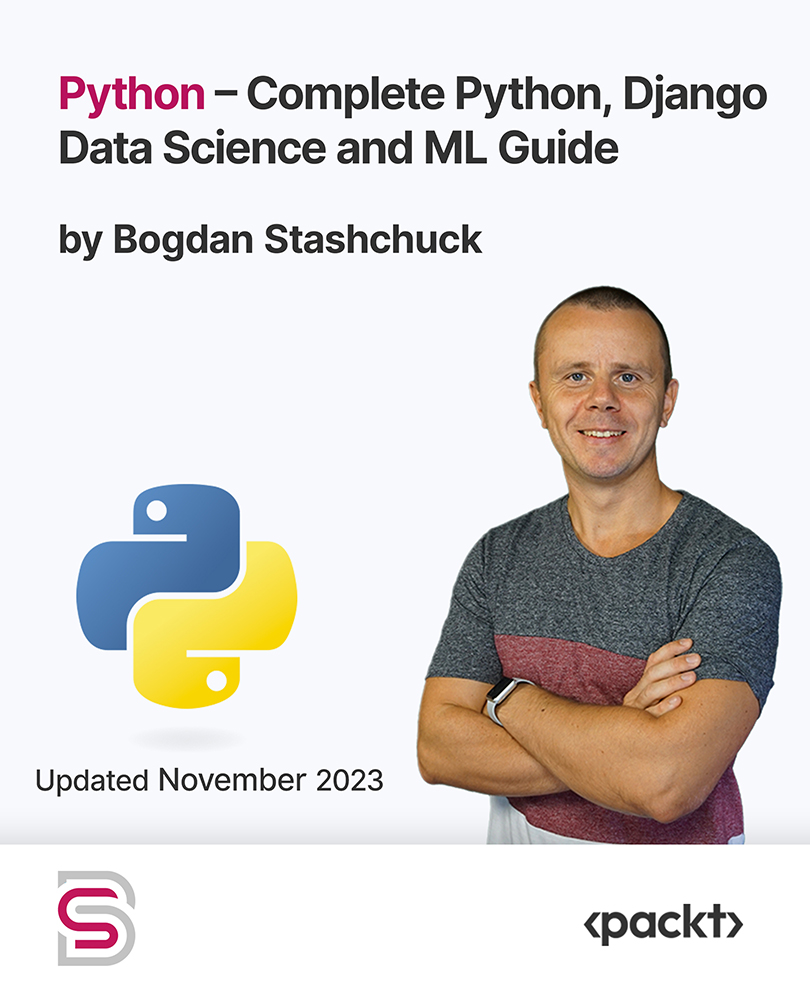-
Book Overview & Buying

-
Table Of Contents
-
Feedback & Rating

Python – Complete Python, Django, Data Science and ML Guide
By :

Python – Complete Python, Django, Data Science and ML Guide
By:
Overview of this book
Join us on an immersive Python programming journey, spanning over 50 hours of learning. Whether you're a novice or experienced, this course equips you with vital Python skills for careers and projects.
Starting from the basics, grasp Python's core principles and proficiency in real-world functions. As Python's popularity grows, this course readies you for the rising demand for Python developers. You'll practice hand-on examples using Python's interpreter and Visual Studio Code with Code Runner to solidify your skills.
With a focus on Data Science and Machine Learning, you'll master essential packages such as NumPy, Pandas, Matplotlib, and Scikit-learn, using the versatile Jupyter Notebook. The course extensively covers Python's fundamental aspects, spanning variables, lists, dictionaries, and venturing into advanced topics like classes, loops, modules, and creating virtual environments. The goal is to provide you with a solid Python foundation. You'll also gain insight into functional and object-oriented Python programming, making you a versatile coder.
The course is thoughtfully structured, explaining not just "how" but also "why" we use specific methods and best practices. By course end, you'll harness Python's full potential for web and mobile app development, data science, machine learning, and game creation.
Table of Contents (91 chapters)
Introduction to Python
Installing and Using Pycharm IDE
Basics Concepts in Python
Introduction to Functions and Built-in Functions in python
Code formatting and PEP8
Expressions and Instructions
Data Types and structures
String Concatenation
Numeric Types
Boolean Values
Lists
Dictionaries
Sets
Working with Sequences
Modifying Objects in Python
Function Arguments
Args and kwargs in Functions
Default Function Parameters
Docstrings
Callback Functions
Global and local Variables
Operators
Falsy and Truthy Values
Logical and Comparison Operators
Lambda Functions
Error handling
Sequence Unpacking
Unpacking Dictionary
Conditional Statements
Ternary Operator
For-In loop
While Loop
For-In Expression (Comprehension)
Decorator Functions
Classes and Objects
Instance and Class method
Magic Methods in Classes
Classes Extension
Classes in Practice
Key Principles in Object-Oriented Programming (OOP)
Modules
Built-in Modules
What is __name__ and __main__
JavaScript Object Notation (JSON)
Working with Files
Working with zip archives
Working with CSV Files
Working with Dates and Times
Generating Random Sequences and Passwords
Math Module and Recursive Functions
Regular Expressions
Sending Emails
Working with SQLite Database
Other Built-in Modules
Virtual Environments
Pipenv for Virtual Environments Management
Introduction to the Django web framework
Creating a Django project
Creating a Django Application
Database and Migrations in Django
Creating Templates in Django
Extending Other Templates in Django
Creating Multiple routes and View Functions
Routing between Pages in Django
Creating an API Django Application
Managing Authentication for API Requests
Django Project Refactoring and Admin Settings
Creating Games with Pygame
Creating a Shooter Game with Pygame
Interaction of the Elements in the Pygame
Game Refactoring using Classes and OOP
Jupyter Notebook
Jupyter Lab
NumPy - Creating Arrays
NumPy – Random Values
NumPy – Examples
Pandas – Working with DataFrames and Series
Pandas – Random Data Working with CSV
Pandas – Analysing CSV- Loaded DataFrames
Matplotlib – Creating Charts
Scikit – Learn - Machine Learning
Machine Learning Model for Real Data
Making Machine Learning Model More Real
Customer Reviews

